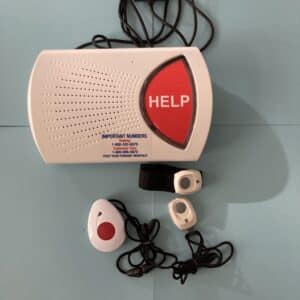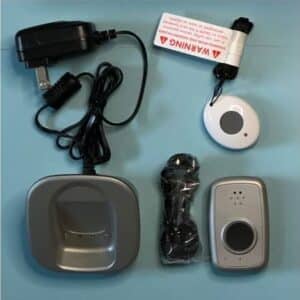While many medical alert systems with fall detection include equipment and monitoring fees, MobileHelp offers no extra fees for most medical alert devices. Only one model, the Classic at-home system, has a $49.95 processing fee. The fee is waived if you purchase quarterly, semi-annual, or annual payment plans.
Best medical alert systems with fall detection in 2024
- MobileHelp: Best Overall Value
- Medical Guardian: Most Responsive
- Medical Alert: Best Fall Detection
- LifeFone: Most Features
- ADT Health: Most User-Friendly
Best medical alert systems comparison, as of February 2024
Our comparison table below allows you to easily compare prices and features of the best medical alert systems with fall detection of 2024.
| Monthly cost | $19.95+ | $29.95+ | $19.95+ | $24.95+ | $29.99+ |
| Range | 600–1,400 feet | 1,300–1,400 feet | 800 feet | 1,300 feet | 300–600 feet |
| Connection type | Landline, AT&T cellular | Landline, AT&T cellular | Landline, AT&T cellular | Landline, AT&T or Verizon cellular | Landline, AT&T cellular |
| Response time | 25–50 seconds | 1–25 seconds | 15–25 seconds | 1–25 seconds | 45+ seconds |
| Battery life | 30 days | Up to 5 days | Up to 5 days | Up to 10 days | 20 hours |
Our Reviews Team researched and tested the top medical alert systems on the market to help you make an informed decision for yourself or your loved one.
5 features to consider when choosing a fall detection device
Medical alert systems with fall detection often offer a wide range of features and services, making it difficult to determine which features truly matter. Here are our five top considerations to keep in mind when choosing which fall detection service and device will be the right fit for you or your care recipient:
1. Accuracy and reliability
One of the most important features of a fall detection device is its ability to detect real falls and minimize false alerts accurately. Seek out monitoring devices with multiple sensors and published clinical studies determining the device’s accuracy across diverse fall scenarios, such as a slow fall from a seated position or a hard fall while standing. A device utilizing accelerometers along with other sensors like gyrometers typically offer higher fall detection accuracy.
2. Detection speed
The faster your device detects a fall, the faster you can receive help from first responders. Look for devices with a strong record of quickly connecting users with a monitoring center—in our testing, we’ve determined an ideal speed to be 30 seconds or less.
3. Range and GPS capabilities
Range and GPS capabilities can vary based on indoor or outdoor use. If a device’s range relies on a stationary home base, it typically will have a limited range, when compared to wearable devices with GPS. On-the-go devices often allow location tracking and emergency detection no matter where you are. Determining the range you need in a device depends on the user’s activity levels and falls risks.
4. Ergonomics and wearability
The ideal fall detection device is lightweight, comfortable, and easily operated. Many companies also offer fashionable or more subtle devices like jewelry snap-ons for pendant necklaces and wristband styles. These devices blend in with the user’s everyday wear, making them more user-friendly.
Additionally, consider choosing a waterproof medical alert device, as they offer greater protection in high-risk areas like kitchens and bathrooms. Other factors to consider include battery life, so you can minimize the time needed to take the monitor off to recharge, and systems that offer reminder alerts, like medication and appointment reminders, which can help boost compliance.
5. User interface and displays
Everyone can benefit from technology with intuitive, user-friendly interfaces, though these features are especially important for the cognitively impaired. Seek devices with clear, simple displays, customizable text size, and audible guidance and alerts.
Frequently asked questions
Fall detection costs $10 per month on average. It’s typically offered as an additional fee for an existing medical alert system. Companies like Lifeline and UnaliWear, include fall detection costs in the price of their medical alert systems.
Medicare Advantage, also known as Part C, may partially cover medical alert devices with fall detection but Medicare Part A and Part B do not offer coverage. Coverage varies by state, and you can learn more through our article on whether medical alert systems are covered by insurance. To fully understand your individual coverage, you’ll need to reach out to your insurance provider.
One of the most important features in fall detection systems is “automatic” fall detection. Without automatic fall detection, the system is the same as having a standard help button you press when you have an emergency.
We recommend waterproof fall detection devices, since falls frequently happen in the bath or shower. As a result, all devices on this list are either waterproof or water-resistant. Waterproof means the device is airtight and can withstand water no matter how long it’s submerged. Water-resistant means it can withstand water to a certain degree, but not entirely. Typically, you could wear a waterproof device while swimming but a water-resistant device should only be worn in the shower.
Lastly, your fall detection device should be comfortable, easy to wear, and suit your personal style. You’re less likely to wear a device if you find it clunky or unattractive.
The accuracy of a fall detection system depends on the technology the device uses. Fall detection devices with the best accuracy use several tools to determine the difference between a fall and a normal movement.
For optimal accuracy, you may want to choose a fall detection necklace. Research shows medical alert bracelets and watches aren’t as accurate at detecting falls as necklaces. [2] Javier González-Cañete, Francisco and Casilari, Eduardo. A Feasibility Study of the Use of Smartwatches in Wearable Fall Detection Systems. Sensors. March 23, 2021. Found on the internet at https://www.mdpi.com/1424-8220/21/6/2254 [3]Lee, Yongkuk, et al. Experimental Study: Deep Learning-Based Fall Monitoring among Older Adults with Skin-Wearable Electronics. Sensors. March 2023. Found on the internet at https://www.mdpi.com/1424-8220/23/8/3983 Often, normal arm movements trigger a false alarm. While there are fall detection devices that fit in your pocket, the extra layer of fabric can prevent the device from sensing a fall.
Anyone who has a medical condition or lives alone should consider a fall detection device. Falls are the leading cause of serious injury among older adults, according to the CDC. [8]Centers for Disease Control and Prevention. Older Adult Falls Data. Found on the internet at https://www.cdc.gov/falls/data/index.html
A standard home medical alert system may not provide needed protection if you can’t reach the base station or wall-mounted help button after a fall.
Medical Guardian, MobileHelp, LifeFone, ADT Health, and Medical Alert are our preferred brands for fall detection devices. But your individual needs will help determine the best option for you, taking into consideration your lifestyle, preferences, and budget.
All devices from Medical Alert have the option to add fall detection. While not all devices have fall detection for Medical Guardian, ADT Health, and LifeFone, a majority do have the option to add fall detection.
Your needs, preferences, and lifestyle will determine your best wearable device for fall detection. While our top pick is MobileHelp for its fall detection technology, fast response time, and cost-effective options, factors such as comfort, ease of use, on-the-go capabilities, and other, personal requirements should determine your decision. Different devices suit different people. So it’s important to compare various products and ask questions while choosing the ideal fall alert device for you.
Yes. But even though some companies sell wearable fall detection options with no monthly fees, we haven’t found any reliable options we can recommend. We caution against purchasing any fall-detection devices promising free services or seem questionable. Since fall detection devices are needed for emergencies, it’s best to invest in a trusted and proven product, even if it does come with monthly fees.











